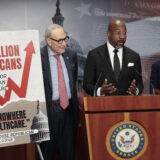Labor & Economy
Supreme Court v. Working People

Two recent U.S. Supreme Court decisions involving especially high profile cases have garnered all the legal headlines. The Court’s watershed decision rejecting Proposition 8 and restoring the legality of same-sex marriage in California gave new rights to a significant portion of American citizens – and gave blue states something to shout about.
Days before, red states held their own party after a court majority ruled that the 1965 Voting Rights Act was unconstitutional because it relied on data from the 1970s that was supposedly outdated. Immediately, officials in North Carolina, South Carolina, Texas, Mississippi and Alabama – all states covered by the law – got to work adopting restrictions limiting the vote of the old, the poor and people of color.
Just before these two momentous decisions, however, when no one was paying attention, the high court gave the country to the corporations — again. The Supremes handed down a decision that curtailed the avenues that employees have used to redress instances of religious or racial discrimination.
In a Texas case, Dr. Naiel Nassar had reported discriminatory behavior by his supervisor at the University of Texas Southwestern Medical Center; then, when he applied for another position in the hospital, he was not hired. The victim filed a lawsuit charging retaliation, which he won, but which SCOTUS overturned. So now if your supervisor harasses you on the job for race or religion, the supe is more likely to get away with it.
Another decision involved a university employee named Maetta Vance, who had sued her employer alleging that a supervisor – the person who assigned and monitored the woman’s work – had created a racially hostile work environment. But the Supremes decided that since the supervisor did not also have the power to hire, fire or promote, the supervisor wasn’t, well, a supervisor, and the employee could not sue the employer. The judges ruled that without that authority a person who delegates tasks and oversees work is just a “co-worker,” and harassment complaints are illegitimate.
Most of us missed those cases because no one talked about them much. That is not by accident. While the Court typically hears cases in the fall and releases its verdicts the following June, the order of those announcements is opaque at best. The rules of the Court neither spell out who makes these scheduling decisions nor is there a transparent, systematic procedure that sets a time-table for making decisions public.
One court watcher wrote me: “My guess is that the releases are done on a case by case basis. It is easy to see how the release order and timing could make a big difference in public perception.” Indeed.
So people who care about worker rights need to pay close attention as two more key decisions come down the road. The influential District of Columbia Circuit Court just ruled that the National Labor Relations Board cannot require companies under its purview to post employees’ rights in the work place. Guess what? It violates a corporation’s freedom of speech! If the Supreme Court supports this reading, workers will have no right to work-site-located information regarding their rights and their ability to redress grievances.
In a second case, the Court assented to review the legality of “neutrality agreements” – those pacts between unions and employers which guarantee a fair environment for workers to organize in and join a union by simply signing cards instead of holding a long, drawn out and expensive balloting process. If the court affirms this reading of the law, worker rights will be more difficult to secure and enforce. Organizing a union in the work place will become immeasurably harder and more complicated – and therefore more expensive for unions to attempt these campaigns.
In Santa Monica a half-dozen hotel construction projects stand in line for approval, and like hotel developers across the country, the builders will eagerly anticipate this case. They know it will make organizing a union more difficult and infinitely more difficult for workers to ensure their rights on the job. Given the current experience with the release of SCOTUS decisions, workers should be watching just as carefully, not only because they have a lot at stake, but because the Supremes are likely to slip these announcements as far under the radar as they can.

-

 Latest NewsDecember 8, 2025
Latest NewsDecember 8, 2025This L.A. Museum Is Standing Up to Trump’s Whitewashing, Vowing to ‘Scrub Nothing’
-

 Striking BackDecember 4, 2025
Striking BackDecember 4, 2025Home Care Workers Are Losing Minimum Wage Protections — and Fighting Back
-

 Child FarmworkersDecember 5, 2025
Child FarmworkersDecember 5, 2025To Protect Underage Farmworkers, California Expands Oversight of Field Conditions
-

 Column - State of InequalityDecember 4, 2025
Column - State of InequalityDecember 4, 2025Can California Claw Back Some Medi-Cal Care?
-

 Latest NewsDecember 10, 2025
Latest NewsDecember 10, 2025Capital & Main, L.A. Times Win Sidney Award for Reporting on Child Farmworkers
-

 StrandedDecember 9, 2025
StrandedDecember 9, 2025Giving Up on the Dream: Asylum Seekers Try Other Options in Mexico
-

 Locked OutDecember 16, 2025
Locked OutDecember 16, 2025This Big L.A. Landlord Turned Away People Seeking Section 8 Housing
-

 Column - California UncoveredDecember 12, 2025
Column - California UncoveredDecember 12, 2025They Power the U.S. Economy, But Will Struggle to Afford Health Care

